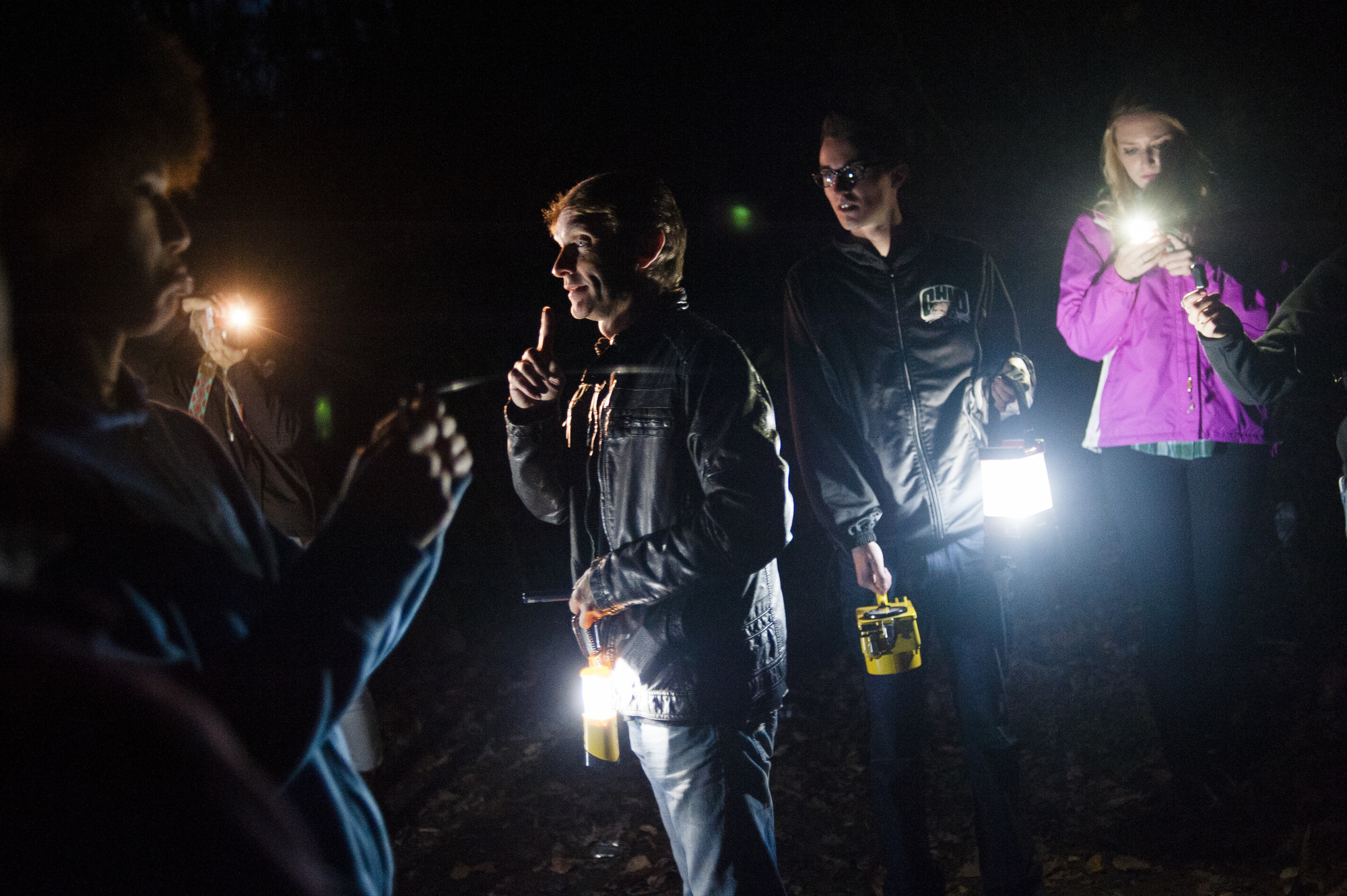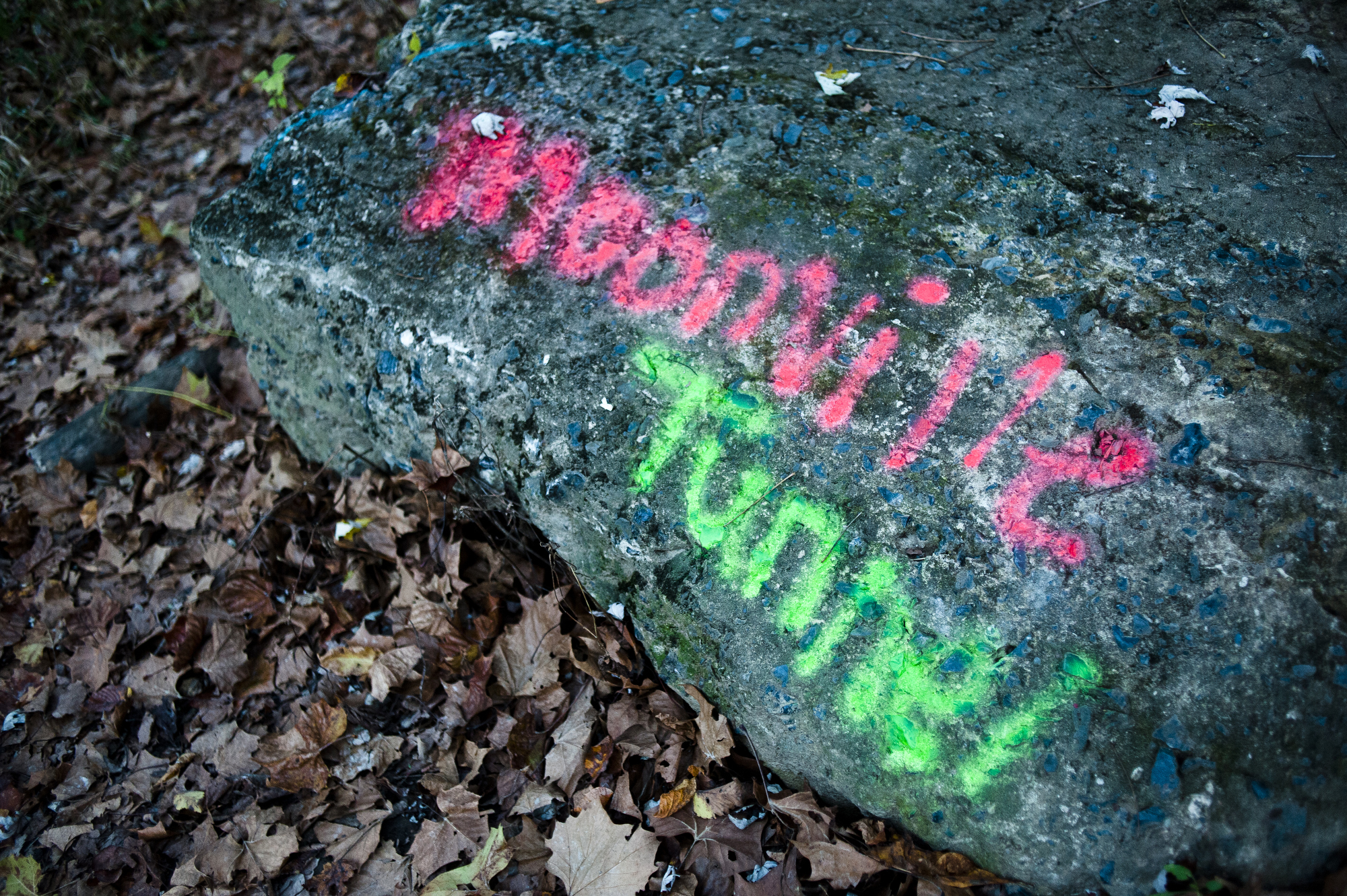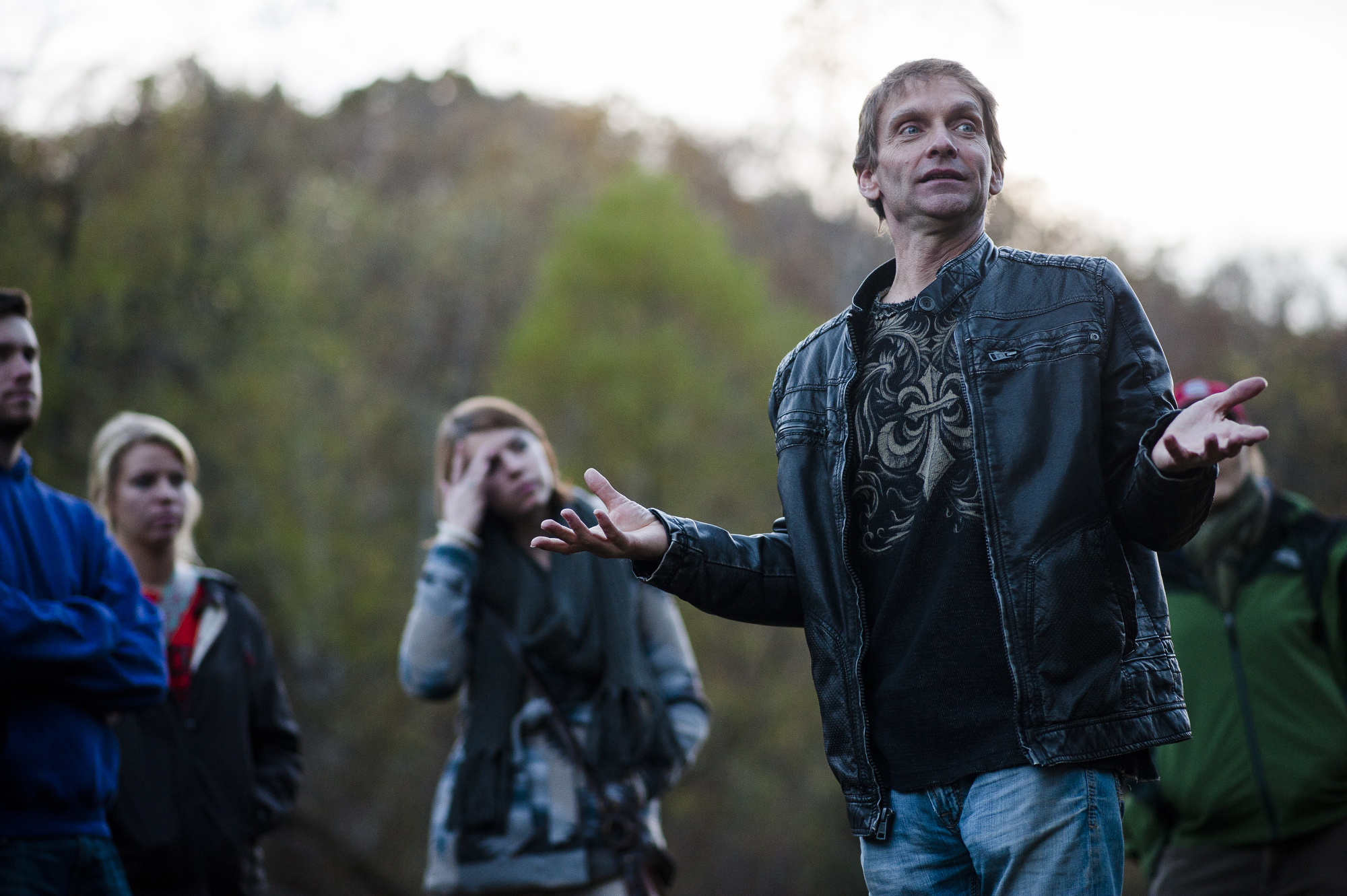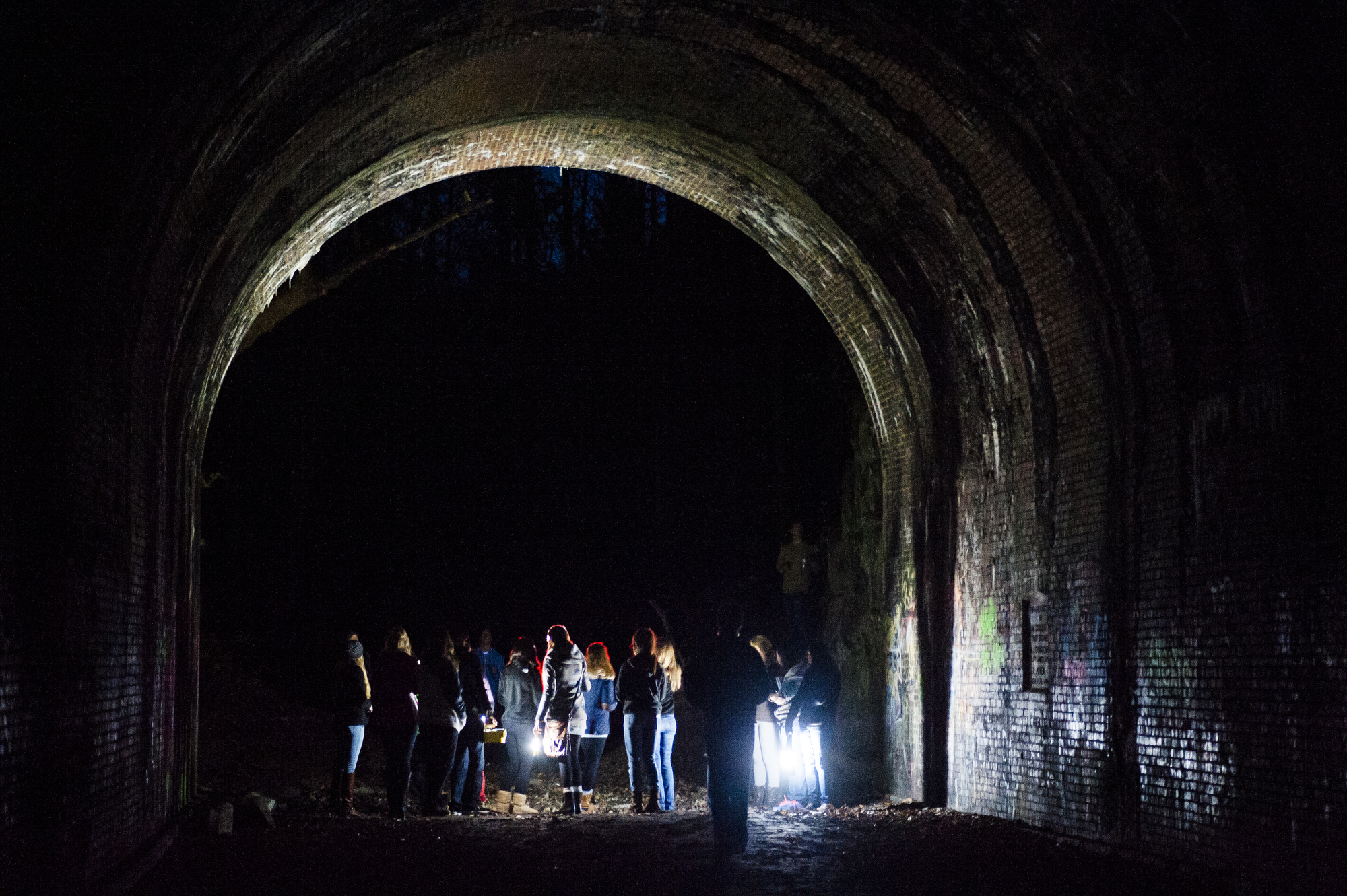
The cover of the second in a series of seven books about the paranormal in Ohio features a photo of a young girl holding a candle and gazing ominously at the camera.
The image conjures up a creepy Poltergeist feeling. But the young girl isn’t an actress or a ghost—she is the daughter of the book’s co-authors, Patrick and Jannette Quackenbush, who run the Haunted Hocking Investigation Team.
Perhaps you could call Patrick and Jannette Quackenbush’s work a quest from love. They married 30 years ago, and for last 16 years the ghost-hunting couple has toured the area to uncover stories about locations with reportedly strange occurrences.
The team’s craft
Drawing from the background they received in history and nature as students at Hocking College, the Quackenbushes launch paranormal investigations throughout the year based both on submissions from community members and the couple’s curiosity. Each story they investigate is met with intense scrutiny. “You have to convince me that your story is real,” Patrick explains of the approach he and his wife take toward submissions.
Over the years, the couple has investigated almost 600 stories, with two to three big investigations each year. The Quackenbushes take a basic approach to most investigations, using audio, video and still images.
Jannette often scours old newspapers to uncover new stories for the couple to explore. “I really, really enjoy finding the old, historical ones that nobody has,” she says. “It’s almost like a high when I get that ghost story and find that it’s real.”
The work is far from over once the couple decides which story to investigate next. They must verify the information of the story, even checking whether the ghost in question ever existed as a person. Basically, the couple needs to substantiate the stories. Once Patrick and Jannette verify background information, they head to locations to conduct a scientific investigation, using their tools to search for definite proof.
The Quackenbushes frequent events in Southeast Ohio, partner with organizations and even help at fundraisers. The team also routinely takes groups out on tours of locations they have investigated and shares information about the area, the folklore and how to use ghost-hunting gear like the pros.
“One of the things we pride ourselves in at Haunted Hocking is that we make it accessible to you. Our goal is that we love to see other people having a good time with it,” Patrick says. “Anybody can do this. It’s a really cool, fun and fascinating pastime. It’s definitely something we love to share with other people.”
Each ghost hunt is different for the team, and the results vary. Sometimes, investigations have interesting results, but other times nothing pans out. But the team won’t lie—even if attendees want evidence of the paranormal.
“I think a lot of times, people want to see things in images that they send us. You want to see things in images—orbs or other things, but you don’t,” Jannette says. “They may just be bugs or dust in pictures. A lot of times you need an EMF [electromagnetic field] meter or a camera there, a digital voice recorder so that if they see an orb or something like that, they also have other things to back it up.”
Patrick, who by day is a naturalist for Ohio State Parks in the Southeast District, will be the first to tell someone that the shadowy figure they’re seeing is just a deer. He also might treat the group to a little added fun by performing owl calls.
“We will not make it up. We will not fake it. There’s been many public ghost hunts [where] we’ve walked away without a thing,” he says. “But we’ve also had some really cool things happen at the public ghost hunts. We just never know what’s going to happen when we get out there.”
Science and history collide
There will always be skeptics when it comes to the paranormal, which the Quackenbushes accept. Patrick considers himself to be the biggest skeptic when it comes to each individually submitted story. That’s why the team bases all of its investigations on science and history. The team checks the facts before an investigation is even launched, and once it is, scientific proof is needed.
“It’s not set science—it’s new science,” Patrick says. “We’re using old science and old techniques in an attempt to develop new scientific attempts for this.”
The most commonly accepted principle in the science of ghost hunting is that ghosts are energy. That energy can manifest itself in a number of ways, whether through magnetic field manipulation, audio or video. The Quackenbushes have had experiences with each form.
“When we started doing this early on, people would say, ‘Wow, do you believe in ghosts?’” Patrick says. “I’m a true believer now. Way too many things have happened, way too many photographs to discount it anymore.”
By using a trove of gear, the Quackenbushes are able to detect any number of those manifestations. The team has an arsenal of methods for finding fields of energy, including EMF detectors and cameras that detect energy in spectrums beyond what the human eye can see. The team also carries a crystal on a string to confirm activity they’ve already found and brings it with them on public ghost hunts to teach people about the historical method, which has been used for centuries and is one of the oldest ways to detect energy fields, Patrick explains. When the crystal is held over an energy source, it gyrates.
“You can’t rely on any one [method]; you have to use a combination,” Patrick says. “I work on the old Sherlock Theory. His old saying is that ‘when you have eliminated all the possibilities, whatever’s left, however improbable, must be the truth.’ That’s what we’re trying to do.”
Finding that truth isn’t always easy, though. Patrick notes that for every thousand pictures the team takes on an investigation, only one might have an interesting outcome.
The investigation begins long before the Quackenbushes load up their SUV with equipment. The couple spends plenty of time researching each area to gather the historical background of the site.
Southeast Ohio is an ideal backdrop for the investigation team. The rich history of the region contributes to the paranormal instances. Patrick explains that the days when iron and coal towns made the region the wealthiest in the state have provided many stories. “You’ve got all of these little iron and coal towns that are pretty much gone now, but they’ve left a mark behind of something,” he says. “If you do a little research, you find the everyday lives, the accidents, the murders, the suicides. A lot of those strong emotions add to that.”
When many think of the paranormal in Southeast Ohio, he notes, they naturally assume the former Athens Lunatic Asylum holds much of the region’s hauntings. He explains that while the old asylum has plenty of history, the haunted aspects of the buildings are not as strong as many believe.
Places like the Hope Iron Furnace and the Moonville Tunnel provide even more haunted experiences.
The ghosts of Moonville Tunnel
The graffiti-littered walls of the Moonville Tunnel offer more history than words and drawings in vibrant hues would lead one to believe. But the tunnel is said to have more guests than those wielding cans of spray paint.
Patrick spent a crisp October evening showing the tunnel to Ohio University students in a learning community and teaching them the ghost stories of the area— with a little science and history mixed in. “My goal is to add no new ghost stories tonight,” Patrick warned before setting out on the ghost tour.
Prior to leading the students down a trail that leads to the tunnel, he explained the function of each piece of gear and passed equipment around to tentative participants. Calling volunteers forward, he showed how the bent pieces of metal he turned into dousing rods could reveal a possible spirit in the area.
When level and about ten inches apart above a person’s head, the two rods will cross each other. “You are a massive magnetic field,” Patrick told the students.
Bands of light from lanterns bobbed up and down on the 10-minute trek through the wooded area along a creek, making the path just barely visible to the students. Throughout the walk, the electromagnetic field (EMF) detectors lit up, dousing rods crisscrossed and the crystals drew careful circles, even when students held their hands completely still.
The phenomenon prompted Maddie Weir, a freshman in the learning community, to shriek and many other students to fidget uncomfortably. Patrick explained the story of how, in 1972, a woman drowned in the creek after falling from the train tracks that once ran over it.
The ghost stories were only the beginning of local lore. When the group reached the tunnel, Patrick had plenty to share, from the story of a young brakeman who was fatally injured in the tunnel to the tale of Baldie Keeton’s murder. Though no one fell victim to small rocks and pebbles falling from overhead on the trip, Patrick explains that he believes Keeton to be the source of the oft-cited falling rocks. Keeton was found dead on the tracks one morning in the late 1880s. Police believe Keeton’s death was a murder, but the culprit was never identified.
With many deaths cited at the tunnel, many of the students eagerly took their tools throughout the dark in hopes of a response. At the end, the EMF detectors repeatedly went off while an ovulus, a specific tool for ghost hunting that spirits can use to communicate with people, spewed garbled words. A circle of students huddled around one another, watching with wide eyes as the machines signaled alarm.
Though none of the words at the end of the tunnel were coherent, Patrick said that when he was setting up other gear at the front of the tunnel, he clearly heard the words “spirit” and “help” from the ovulus. He also reminded students to check the investigation team’s website later on to see if any of the recorders picked up anything.
All possible supernatural experiences aside, Haunted Hocking sought to teach students one important lesson: how to be responsible ghost hunters. Patrick explained that gaining respect is a surefire way to gain access to places most people can’t. He also warned students to receive prior permission before exploring any haunted sites. “We want to teach you how to be a ghost hunter,” Patrick said. “But we want to teach you how to be a good ghost hunter.”
For more information about the Haunted Hocking Investigation Team, visit their website at www.hauntedhocking.com, where the team lists their findings from investigations covering the entire state of Ohio.



